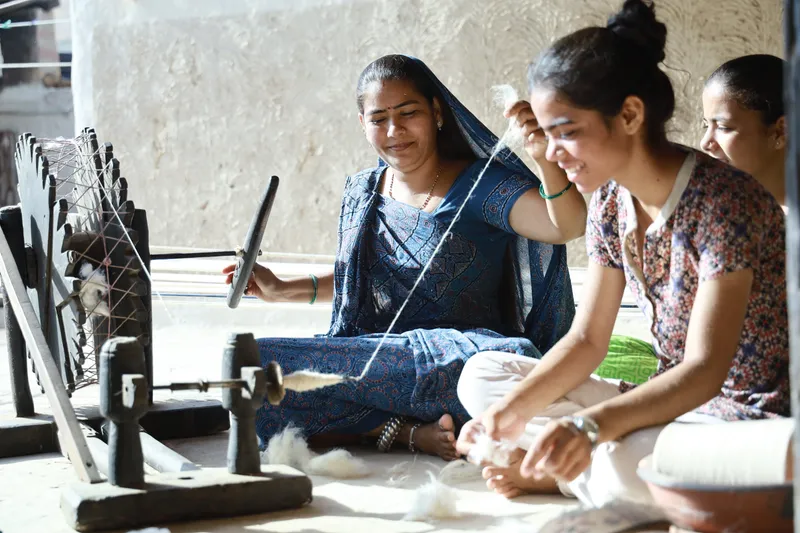Meet the rural artisans who got the opportunity to study at IIM-A
The Creative and Cultural Businesses Programme (CCBP) at IIMA has been curated for entrepreneurs in the creative and cultural industries. Mohammed Saqib, a dyer from Rangrez community in Rajasthan, and Navneet, a weaver from Kutch talk about their experience.
Mohammed Saqib is a fifth-generation artisan of the Rangrez (textile dyer) community in Rajasthan, a community that is famous for the creation of leheriya designs in myriad colours. Saqib’s family has been creating leheriya designs for the past 150 years.
Saqib is one of 30 ‘agents of change’ in the current batch of the Creative and Cultural Businesses Programme (CCBP) at IIM Ahmedabad. The executive programme is focused on creative and cultural entrepreneurs in the country, especially those who are rooted in Indian artisanal craft heritage, and aims at upskilling them.
Mr Anchal Jain, Faculty Co-Chair, Creative and Cultural Businesses Programme, IIMA, says, “While we have fabulous young creative talent in our country and an enviable artisanal craft skill base, we have been lacking proper management and business training for these two critical stakeholders. CCBP programme was seeded in the year 2013 at IIM Ahmedabad to fulfil this gap and seriously stake our claim amongst the global creative and cultural consumers. Students are able to appreciate and learn how value is created in creative businesses and build an ability to put all the value chain elements together to scale their ventures.”
As one of the few remaining craftsmen working on leheriya designs, Saqib was keen to find ways to keep the tradition alive.
In a chat with SocialStory, Saqib shares his journey of being a part of the prestigious institute.
“One of my colleagues sent me the link to this course at IIM-Ahmedabad, and it came to me at a point when I felt quite stuck as to how to move forward in the family business, and do something different. I applied, got selected, and once I went there, I realised there was more to business than what we had known all along,” shares Saqib.
“After designing my craft, I wasn’t aware of how to take it forward in terms of marketing or promoting it. I never knew there was something like understanding the market and customer needs, customising my product accordingly, etc. The CCBP programme taught me all that and more,” says Saqib.
He shares that while the earlier generation used to sell the traditional leheriya designs in melas (fairs), the new generation has a plethora of platforms to make use of, but they need to be educated on how to best utilise them. Saqib also has a physical outlet attached to his residence in Jaipur, Rajasthan, where customers can buy the leheriya garments directly from the source.
Started in 2013, the CCBP has impacted businesses of over 200 entrepreneurs in fields such as fashion, fragrances, jewellery, art, performing arts, travel, hospitality, F&B, home decor and design.
Designed for entrepreneurs with an existing business, now ready to scale or diversify, or ‘Want-to-be Entrepreneurs’ with a very well-defined idea, the programme has seen most participation from artisans in Kutch, Maheshwar, Varanasi, Warli, and Uttarakhand.
The Institute provides an 80% fee waiver for two to three artisans in every batch, and the remaining fees are sponsored by NGOs or organisations that seek to support artisans.

Navneet Siju (left) from Kutch and Mohammed Saqib from Jaipur are into weaving and leheriya crafts respectively. Both got the opportunity to study at the Indian Institute of Management, Ahmedabad.
Government approves 23 strategic projects under National Technical Textiles Mission
From the Rann of Kutch
Navneet Siju is the grandson of Vankar Vishram Valji of Bhujodi, Kutch in Gujarat. Vishram Valji had won the ‘Best Craftsman Of The Year’ title from Prime Minister Indira Gandhi in 1974, after one of the blankets designed by him was entered for a contest.
Navneet, the youngest artisan in the family, shares, “Until the early 80s, our work used to be community work. We weaved specific and certain products for local communities. It included shoulder shawls for men and woollen blankets. It was more of a barter system back then.”
Between 1980-1990, machine-made textiles entered the market, and as a result, demand for handmade products decreased. “Due to this, we struggled to keep our traditional craftsmanship alive. But with time, new people who travelled to Kutch showed interest and we managed to keep the culture alive with their help. This is when we also realised that customisation of our craft in accordance with market trends was necessary, but without losing the craft’s authenticity.”

Weavers at Navneet’s family loom in Kutch
Two years ago, Navneet met a girl from the local community who had also attended the CCBP course at IIM-A. He says, hearing about it from her inspired him to apply, but he waited for things to normalise after the pandemic so that he could also visit the campus at Ahmedabad.
“Attending the six-month course gave me great insights into running by business end-to-end – from marketing and accounting to promoting the products and positioning them in the market,” says Navneet.
He says his overall point of view so far was that of a manufacturer, but the course helped him view his products from a customer’s lens. Navneet’s goal is not limited to simply promoting his own label. He is now keen on reviving the craft, and bringing back the artisans from his village who have migrated to the cities.
“A few years ago, looms in Kutch had reduced to about 800 in number. Now there are about 1,200 looms. While there is an increase, I would like to see at least 1,500 looms running on a daily basis,” says Navneet.
He also wants to help build connections between weavers and art & craft enthusiasts (clients) to keep the community and this precious form of Indian art alive, he concludes.
Edited by Megha Reddy






